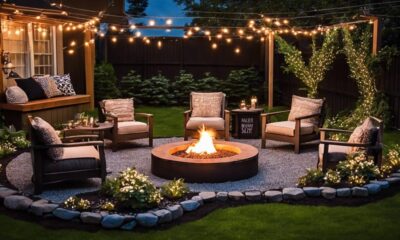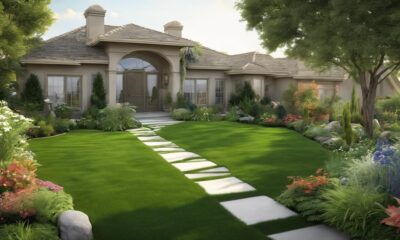Architecture Home Styles
10 Ways to Improve My Ranch Style House
Fashioning a dream home with 10 innovative upgrades for your ranch-style house will redefine your living space.
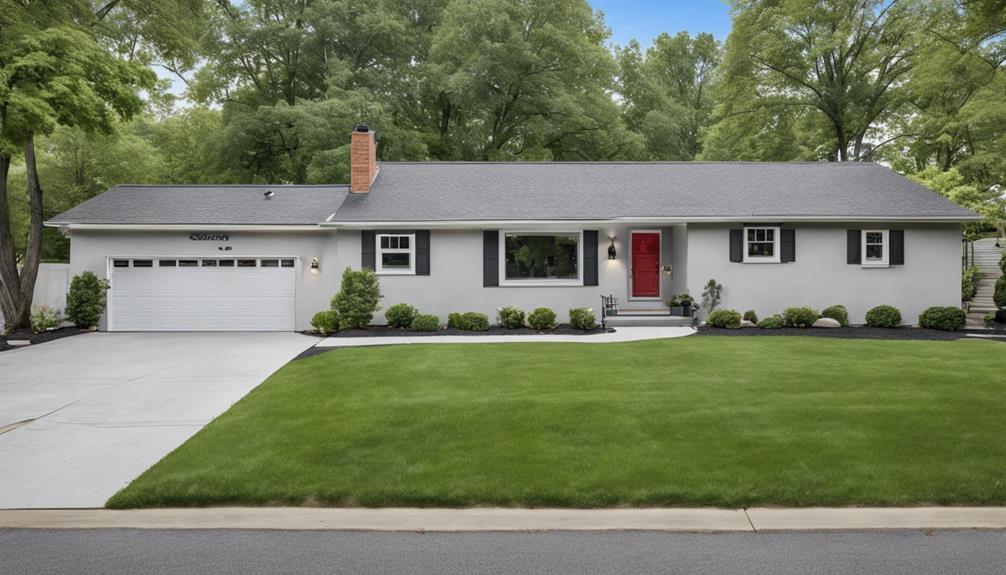
As we stand at the threshold of our ranch-style house, envisioning the possibilities that lie within, we contemplate the 10 ways to enhance its timeless appeal.
From updating landscaping to incorporating modern interior touches, each step holds the promise of transforming our beloved abode into a sanctuary of style and comfort.
Let's explore together how these strategic improvements can elevate not only the aesthetics but also the functionality of our home, creating a space that truly reflects our vision and personality.
Key Takeaways
- Enhance curb appeal with varied landscaping heights and raised planters.
- Modernize interiors by integrating sustainable materials and smart home technology.
- Save on energy costs with efficient windows, HVAC, insulation, and smart thermostats.
- Create an outdoor oasis with fire pits, pergolas, water features, and cozy seating.
Landscaping Updates
To enhance the curb appeal and elevate the aesthetic of your ranch-style house, consider incorporating vertical elements and varied landscaping heights in your landscaping updates.
By introducing vertical elements like tall trees or eye-catching potted plants, you can effectively break up the long horizontal lines of your home, creating a more dynamic and visually appealing exterior.
Adding raised planter boxes or multi-tiered planters can also play a key role in adding visual interest and creating the illusion of height in your landscaping design.
These features not only enhance the overall look of your property but also help differentiate landscaping elements by height and distance, keeping the eye engaged and intrigued.
Modern Interior Touches
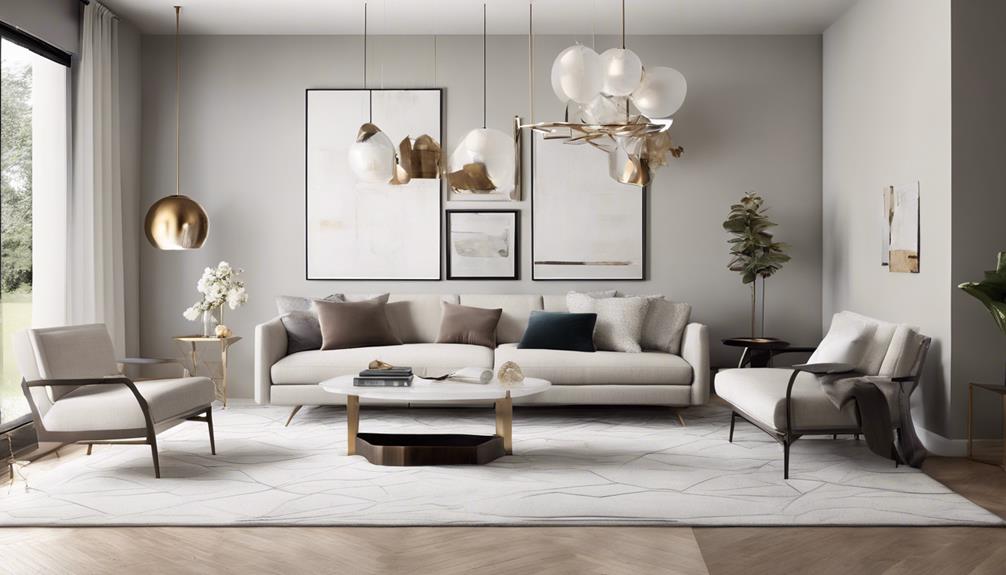
Incorporating contemporary design elements like clean lines, minimalistic furniture, and sleek finishes can bring a modern touch to the interior of a ranch-style house.
To enhance the eco-friendly aspect of the home, consider integrating sustainable materials such as reclaimed wood, bamboo flooring, and energy-efficient appliances.
Adding pops of color through accent walls, bold artwork, and vibrant accessories can inject a lively and dynamic atmosphere into the space.
For increased convenience and efficiency, installing smart home technology like programmable thermostats, smart lighting systems, and energy monitoring devices is key.
To achieve a stylish and updated look, mix traditional ranch house elements with modern decor pieces like geometric patterns, metallic accents, and innovative furniture designs.
Exterior Painting Ideas
Lighter paint colors can instantly transform the exterior of an older ranch home, giving it a modern and refreshed appearance. When considering exterior painting ideas for a ranch style house, here are some innovative suggestions to modernize your home:
- Incorporate raw shiplap shutters and new posts to add texture and depth to the exterior.
- Consider painting brick exteriors with a mineral-based masonry paint for a fresh and stylish look that maintains the brick's texture.
- Experiment with contrasting colors for trim and shutters to enhance the visual appeal of the house and create a striking color palette.
Additionally, adding decorative shutters can give windows a more substantial and attractive appearance, further enhancing the overall aesthetic of your ranch style home. By paying attention to the color palette, texture, and details such as decorative shutters, you can elevate the exterior of your ranch house to new heights of style and sophistication.
Energy-Efficient Upgrades
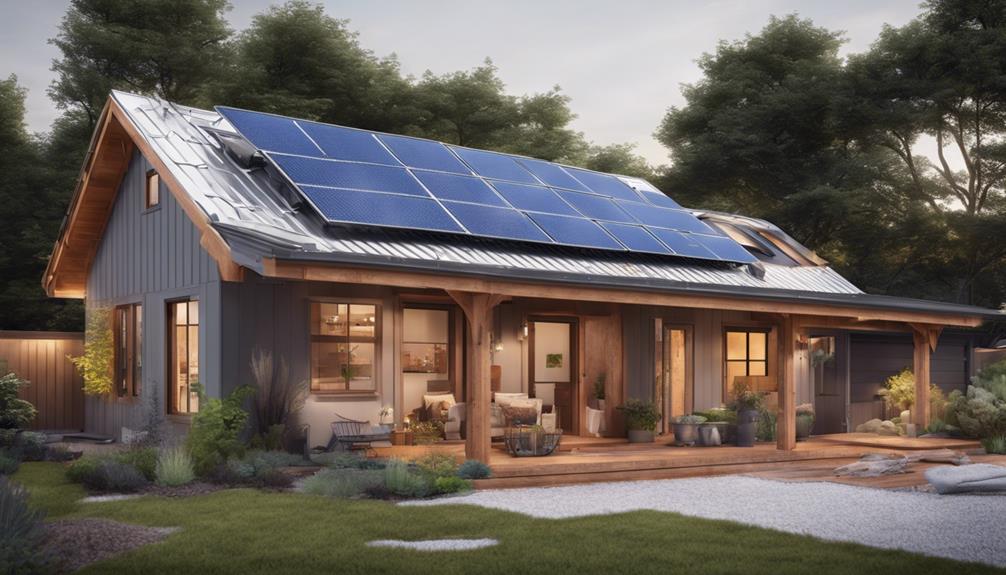
Enhancing a ranch-style house with energy-efficient upgrades can significantly reduce utility costs and increase sustainability.
By installing energy-efficient windows, homeowners can potentially save up to 30% on energy expenses.
Adding solar panels to the roof can lead to savings of over $1,000 annually on electricity bills.
Upgrading to an energy-efficient HVAC system can result in a substantial decrease in energy consumption, ranging from 20% to 50%.
Proper insulation is another crucial upgrade that can lower heating and cooling costs by up to 20% in a ranch house.
Additionally, incorporating smart thermostats into the home can save up to 10% on heating and cooling bills, optimizing energy usage.
These energy-efficient upgrades not only contribute to cost savings but also promote a more environmentally friendly lifestyle. Consider these enhancements to make your ranch-style house more energy-efficient, sustainable, and comfortable for the long term.
Outdoor Living Enhancements
Let's transform our ranch house's outdoor spaces into inviting retreats with our patio upgrade ideas, garden oasis design, and deck renovation tips.
By enhancing these areas, we can create functional and stylish outdoor living spaces perfect for relaxation and entertainment.
With a cohesive design that complements our home's architecture, we can elevate the overall aesthetic and increase the value of our property.
Patio Upgrade Ideas
Elevate your outdoor living experience with a patio upgrade that combines cozy seating, ambient lighting, and stylish decor elements. To create a sophisticated outdoor oasis, consider the following upgrades:
- Fire Pit or Outdoor Fireplace: Add warmth and ambiance for cooler evenings.
- Pergola or Canopy: Provide shade and define your outdoor living space.
- Outdoor Speakers or Sound System: Enjoy music and entertainment while relaxing on your upgraded patio.
Garden Oasis Design
As we envision our ranch-style house's outdoor oasis, a garden oasis design incorporating outdoor living enhancements emerges as the focal point of tranquility and relaxation. To create a tranquil retreat, consider adding water features, cozy seating areas, and lush greenery to the outdoor space.
Elevate both functionality and visual appeal by incorporating elements like a pergola or outdoor kitchen. Achieve a seamless indoor-outdoor flow by connecting the garden oasis to the interior living spaces.
Enhance the ambiance with strategic lighting, comfortable furnishings, and thoughtful landscaping choices in your outdoor living area. By integrating these features, our ranch-style house can transform into a harmonious space where nature and relaxation blend seamlessly.
Deck Renovation Tips
How can we transform our ranch-style house's outdoor space into a functional and inviting oasis?
When considering deck renovation for our outdoor living space, let's focus on enhancing the area with features like seating, dining areas, and planters to create a welcoming atmosphere.
Opting for durable materials such as composite decking ensures long-lasting appeal with minimal maintenance.
To extend the deck's usability into the evening, explore lighting options such as string lights, sconces, or lanterns.
For added comfort and style, incorporate elements like pergolas, fire pits, or built-in seating to make the most of the deck renovation.
Let's elevate our outdoor living space with these innovative ideas:
- Upgrade seating options for comfort
- Create designated dining areas for al fresco meals
- Integrate stylish planters for a touch of greenery
Functional Storage Solutions

To enhance the functionality and aesthetics of your ranch house, consider integrating innovative waste and recycling cabinets for efficient storage solutions. By promoting waste separation and recycling through various cabinet sizes and designs, you can maintain a clean living space while reducing your environmental impact. These storage solutions not only streamline waste disposal but also encourage organized waste management practices, creating a more sustainable home environment.
| Cabinet Type | Features | Benefits |
|---|---|---|
| Pull-Out Recycling Bins | Separate compartments for different recyclables | Efficient waste sorting and easy access |
| Trash Compactor Cabinet | Compacts waste for maximum space utilization | Reduces the frequency of taking out the trash |
| Multi-Purpose Storage Cart | Wheels for mobility and adjustable shelves | Versatile storage for various recycling needs |
Implementing these functional storage options can significantly improve your home's waste management efficiency and contribute to a cleaner, more organized living space. Choose custom solutions that cater to your specific needs for a seamless and stylish waste disposal system.
Lighting and Fixture Updates
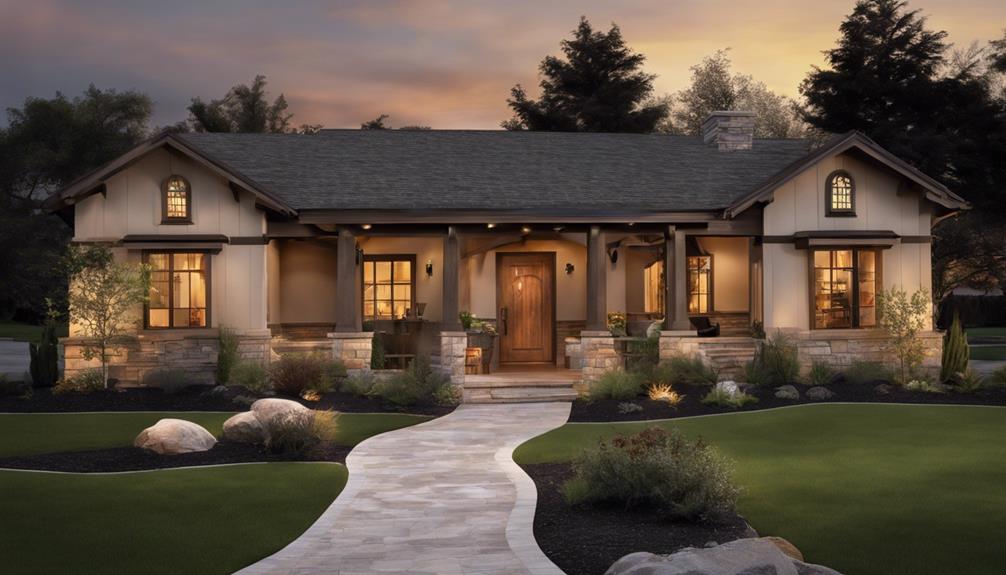
Enhancing the ambiance and functionality of our ranch house, we're now exploring lighting and fixture updates that can modernize and elevate our living space.
By incorporating energy-efficient LED lighting fixtures, we can reduce energy consumption and lower electricity bills while enjoying bright and stylish illumination throughout our home.
Installing motion-sensor outdoor lights not only enhances security but also provides added convenience for our entryways and pathways, ensuring a well-lit and safe outdoor environment.
Upgrading outdated fixtures to modern and chic options instantly elevates the aesthetic appeal of our ranch-style home, creating a sophisticated and welcoming atmosphere for both residents and guests.
With these updates, we aren't only enhancing the visual appeal of our living space but also embracing innovation and efficiency in our lighting choices.
- Consider upgrading to energy-efficient LED lighting fixtures.
- Install motion-sensor outdoor lights for added security and convenience.
- Upgrade outdated fixtures to modern, stylish options.
Patio and Deck Additions

Considering the potential for increased home value and expanded outdoor living space, the addition of a patio or deck to our ranch-style house presents a compelling opportunity for enhancing both functionality and aesthetics. A well-designed patio or deck not only increases the value of our home by up to 10% but also provides a perfect setting for relaxation and entertainment. The average cost to build a patio ranges from $3,000 to $15,000, depending on size and material choices. On the other hand, decks can cost between $3,000 to $30,000 based on size, materials, and complexity. With a professionally installed patio or deck, we can transform our outdoor space into a luxurious area that complements the overall look and feel of our ranch-style home.
| Benefits | Cost Range |
|---|---|
| Increased Home Value | $3,000 – $30,000 |
| Expanded Outdoor Living Space | $3,000 – $15,000 |
| Relaxation and Entertainment | Varies based on choices |
Stylish Window Treatments
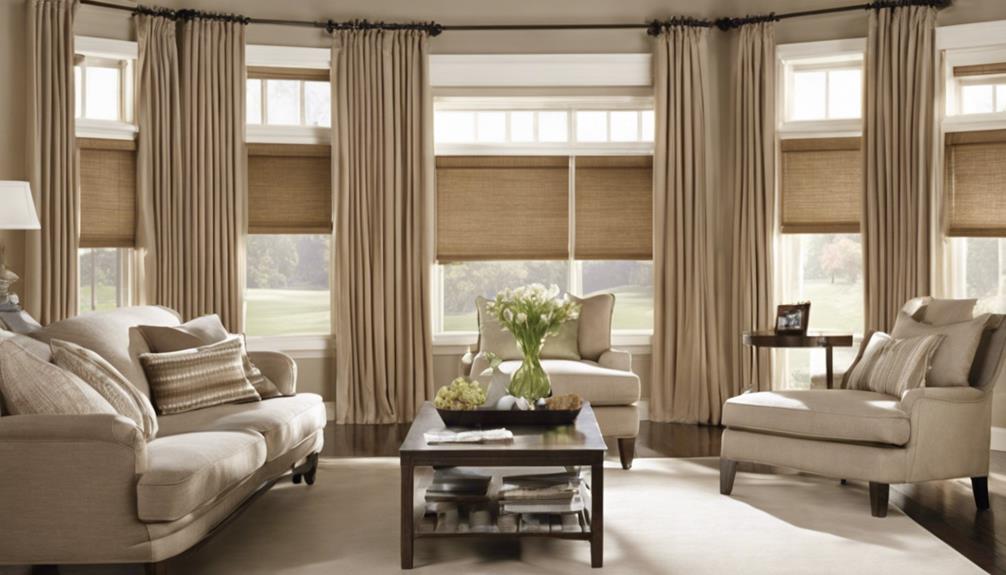
When upgrading our ranch-style house, one stylish addition that can enhance both functionality and aesthetics is incorporating energy-efficient window treatments. By choosing treatments that provide insulation and reduce energy costs, we not only contribute to a more sustainable home but also create a stylish ambiance that complements the ranch style.
- Enhance Insulation: Opt for energy-efficient window treatments like cellular shades or insulated curtains to improve the insulation of your home, keeping it cozy in the winter and cool in the summer.
- Complement Ranch Style: Select window treatments that blend seamlessly with the ranch style, such as wooden blinds or classic shutters, to maintain the architectural integrity of your home.
- Modern Functionality: Explore motorized window treatments for added convenience and a touch of modern functionality, allowing you to adjust light and privacy levels with ease.
Incorporating these elements into your ranch-style house not only elevates its aesthetic appeal but also enhances its energy efficiency and functionality.
Sustainable Design Choices
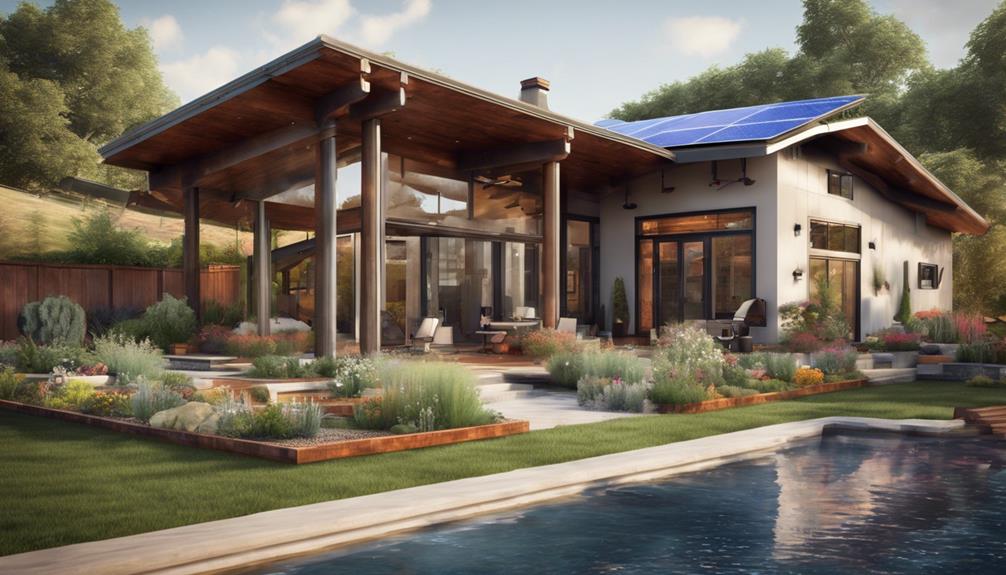
To further enhance the sustainability and eco-friendliness of our ranch-style home, we can make conscious design choices that prioritize environmental impact and long-term benefits. Incorporating eco-friendly materials like reclaimed wood, bamboo, or recycled glass in the construction of our ranch house can significantly enhance its sustainability. Installing energy-efficient windows and doors not only reduces energy consumption but also lowers utility costs, making our home more environmentally friendly. Adding solar panels to our ranch home promotes renewable energy generation, contributing to a more sustainable living environment. Implementing rainwater harvesting systems allows us to collect and reuse rainwater for landscaping, reducing water consumption in our ranch-style property. Choosing native plants for our landscaping design not only promotes biodiversity but also reduces water usage, creating a more environmentally friendly outdoor space for our ranch home.
| Sustainable Design Choices | Benefits |
|---|---|
| Eco-Friendly Materials | Enhances sustainability |
| Energy-Efficient Windows | Reduces energy consumption |
| Solar Panels | Promotes renewable energy generation |
| Rainwater Harvesting Systems | Reduces water consumption |
| Native Plants | Promotes biodiversity |
Frequently Asked Questions
How Can I Make My Ranch House More Interesting?
To make our ranch house more interesting, we can explore various ways to enhance its visual appeal.
Incorporating contrasting textures like wood and metal, choosing a bold front door color, adding decorative shutters or unique lighting fixtures, introducing asymmetrical elements, and updating the landscaping can all contribute to creating a dynamic and visually appealing exterior.
These creative touches will give our ranch house a fresh and stylish look that stands out.
What Is a Good Feature of a Ranch-Style Home?
One standout feature of a ranch-style home is its open floor plan, allowing for a seamless flow between spaces and creating an inviting environment for both intimate gatherings and lively events.
This design element offers a sense of spaciousness and flexibility, catering to various lifestyle needs and preferences.
The open layout fosters a harmonious connection between different areas of the house, promoting a feeling of unity and cohesion throughout the living space.
How Can I Make My Ranch House Bigger?
To make our ranch house bigger, let's consider various options such as adding a second-story addition, converting attics or basements, incorporating room additions or bump-outs, and creating outdoor living spaces like decks or patios.
By consulting with professionals, we can assess structural possibilities for expanding our ranch house.
These ideas will help us maximize our living space and enhance the functionality of our home.
How Do You Increase Curb Appeal of a Raised Ranch?
To elevate the curb appeal of a raised ranch, we suggest adding decorative shutters, updating the front door with bold colors, and using contrasting trim to accentuate architectural features.
Enhancing the front porch with symmetrical planters and cozy seating options can also make a striking impression. These simple yet stylish enhancements can give your raised ranch home a modern and inviting look that will surely catch the eye of onlookers.
Conclusion
In conclusion, after exploring these 10 ways to improve our ranch-style house, we're excited to embark on this journey of transformation.
With a mix of modern touches, energy-efficient upgrades, and stylish design choices, we're ready to take our home to the next level.
As they say, 'A picture is worth a thousand words,' and we can't wait to see our revamped ranch-style house come to life.
Let's get started on this exciting makeover!
- About the Author
- Latest Posts
Introducing Ron, the home decor aficionado at ByRetreat, whose passion for creating beautiful and inviting spaces is at the heart of his work. With his deep knowledge of home decor and his innate sense of style, Ron brings a wealth of expertise and a keen eye for detail to the ByRetreat team.
Ron’s love for home decor goes beyond aesthetics; he understands that our surroundings play a significant role in our overall well-being and productivity. With this in mind, Ron is dedicated to transforming remote workspaces into havens of comfort, functionality, and beauty.
Architecture Home Styles
Exploring the Difference Between Traditional and Classic Design
Kickstart your journey into the world of design by uncovering the subtle yet significant distinctions between traditional and classic styles, shaping your perception of timeless elegance.

When considering traditional versus classic design, we uncover nuanced distinctions in style and aesthetic preferences. The interplay between historical influences and contemporary interpretations provides a fascinating insight into the evolution of design principles.
As we explore the intricate details and subtle nuances that set these two styles apart, it becomes evident that each offers a unique perspective on elegance and sophistication.
Stay tuned to unravel the intricacies that define the essence of traditional and classic design, shedding light on the nuances that shape our perception of timeless aesthetics.
Key Takeaways
- Traditional design features bold colors and intricate patterns, while classic design opts for soft and subdued colors for elegance.
- Both traditional and classic design styles focus on creating a balanced, inviting, and harmonious atmosphere.
- Traditional furniture embodies moderation and balance with solid wood, while classic furniture exudes nobility with gilded finishes.
- Lighting in traditional design aims for warmth and coziness, while classic design creates a luxurious ambiance with ornate fixtures.
Key Elements in Traditional Design
In traditional design, we intricately weave together elements of moderation, elegance, and balance to create a timeless aesthetic inspired by the rich European design traditions of the 18th and 19th centuries. Solid wood plays a pivotal role in this style, exuding warmth and coziness throughout the space. The choice of fabrics like cotton, leather, and velvet further enhances the comfort aspect, inviting you to sink into luxurious textures. Lighting is carefully curated to emanate a soft and inviting glow, achieved through the use of ambient sources such as table lamps and floor lamps, setting a cozy ambiance.
The color palette in traditional design is a symphony of rich colors like deep reds, lush greens, and vibrant yellows, adding depth and character to the space. These hues evoke a sense of opulence and sophistication, harmonizing beautifully with the overall design scheme. The blend of these elements creates a space that not only exudes elegance but also envelops you in a sense of comfort and luxury.
Characteristics of Classic Design

Transitioning from the rich tapestry of traditional design, classic design embodies a timeless allure through its emphasis on neutral hues, enduring furniture pieces, and ageless patterns. Classic design is about creating a space that feels elegant and sophisticated, never going out of style. This style incorporates traditional furniture pieces like wingback chairs and claw-foot tables, showcasing intricate details and a focus on symmetry. Antique or vintage items are often integrated into classic interiors to enhance the sense of heritage and history. Natural materials such as wood and marble play a significant role in classic design, adding a touch of authenticity and luxury. The use of neutral colors like beige, ivory, and taupe creates a serene and calming atmosphere, perfect for those who appreciate a refined aesthetic. Classic design is about capturing the essence of timeless beauty and creating a space that exudes grace and elegance.
| Characteristics | Description | Example |
|---|---|---|
| Neutral Colors | Create a serene atmosphere | Beige, Ivory, Taupe |
| Traditional Furniture | Emphasize heritage and sophistication | Wingback chairs, Claw-foot tables |
| Intricate Details | Showcase fine craftsmanship | Ornate carvings, Embossed patterns |
| Natural Materials | Add authenticity and luxury | Wood, Marble, Leather |
| Timeless Patterns | Enhance the sense of elegance | Damask, Toile, Houndstooth |
Color Palette Variances
Let's delve into the captivating interplay of colors in traditional and classic design, unveiling their distinct palettes and the emotions they evoke within interior spaces.
Traditional design is known for its bold use of color, incorporating rich tones like red, green, and yellow to create a lively and accented color palette. In contrast, classic design opts for a more subdued approach, favoring neutral and soft colors that convey timeless sophistication and elegance. Both styles share a common emphasis on proportion and harmony when selecting colors, ensuring a visually pleasing aesthetic within the space.
Classic design often showcases prestigious materials with subtle contrasts, exuding an air of understated luxury. On the other hand, traditional design tends to embrace vibrant colors and intricate patterns, adding a sense of energy and warmth to the room. The careful selection of color palettes in traditional and classic design plays a vital role in shaping the overall ambiance and character of the interior, showcasing a harmonious blend of elegance, proportion, and timeless sophistication.
Differences in Furniture Styles

Embarking on a journey through the realm of interior design, we are met with a striking divergence in furniture styles between traditional and classic design aesthetics. Traditional furniture in European design, originating from the 18th and 19th centuries, embodies moderation, elegance, and balance. On the other hand, classic furniture exudes noble atmospheres with pomposity, showcasing prestigious materials like oak, mahogany, ceramic, marble, gold, and silver finishes.
| Traditional Furniture | Classic Furniture |
|---|---|
| Rooted in European design | Exudes ethereal nobility |
| Favoring moderation | Prestigious materials |
| Warmth and coziness | Gilded and opulent |
In traditional style, harmony is achieved through blending various elements, offering warmth and coziness with solid wood furniture and fabrics like cotton, leather, and velvet. In contrast, classic style features gilded finishes and gold leaf for a luxurious look, emphasizing richness and opulence. These styles also extend into lighting design, with traditional opting for warmer and softer lighting, creating a cozy feel with ambient lighting solutions like table lamps and floor lamps, while classic style leans towards ornate chandeliers and sconces for a grandiose touch.
Lighting Design Variances
As we delve into the realm of lighting design variances, a captivating interplay emerges between classic and traditional interior styles, each illuminating spaces with unique charm and character. Classic design exudes richness and opulence through lighting fixtures like grand chandeliers and intricately detailed sconces. These ornate details in classic lighting fixtures create a luxurious ambiance, evoking a sense of grandeur and sophistication within a space.
On the other hand, traditional design takes a softer approach, opting for warmer and cozier lighting solutions such as table lamps and floor lamps. The emphasis in traditional design is on creating a welcoming and comfortable environment, where ambient lighting plays a pivotal role in setting the mood. This style aims to promote a sense of intimacy and relaxation, steering away from the grandiose nature of classic design.
Both classic and traditional design styles strive for elegant lighting options that not only serve a functional purpose but also enhance the overall ambiance of a room. Whether it's the opulence of classic chandeliers or the cozy feel of traditional table lamps, lighting design plays a crucial role in shaping the character of a space.
Frequently Asked Questions
How Is Traditional Design Different From Modern Design?
Traditional design differs from modern design in various aspects.
We see traditional design focusing on warmth and rich colors like red and green, while modern design emphasizes sleek lines and minimalism.
Traditional design incorporates natural materials like wood for a cozy atmosphere, whereas modern design utilizes innovative materials for a contemporary look.
The former favors classic furniture with intricate details, while the latter features unique furniture and cutting-edge designs.
What Is the Definition of Traditional Design?
When it comes to traditional design, it's like stepping into a cozy retreat filled with elegant charm. Rich colors like red, green, and yellow dance together, creating a lively palette.
Classic lines and solid wood furniture greet you warmly, while fabrics like cotton and velvet whisper comfort and luxury. It's a timeless style that wraps you in a familiar embrace, making every corner of your home feel like a cherished memory.
What Is the Difference Between Modern Design and Classic Design?
When it comes to modern design and classic design, the distinction lies in their contrasting aesthetics.
Modern design embodies sleek lines and cutting-edge materials, reflecting a contemporary and innovative vibe.
In contrast, classic design exudes elegance and timeless sophistication with its traditional furniture and luxurious details.
These two styles offer a unique blend of old-world charm and futuristic elements, catering to different tastes and preferences in the world of design.
What Is the Difference Between Modern and Classic Home Design?
When it comes to modern and classic home design, the distinction lies in their essence.
Modern design embodies innovation and creativity with sleek lines and cutting-edge materials, ideal for those seeking a contemporary aesthetic.
Classic design, on the other hand, exudes elegance and sophistication through timeless pieces and intricate details, appealing to those who value tradition and refinement in their living spaces.
These contrasting styles offer unique choices for expressing personal taste and style preferences.
How Does Traditional Design Differ from Classic Design in Terms of Aesthetics and Functionality?
Traditional design encompasses a more ornate and intricate aesthetic, while classic design focuses on simplicity and elegance. In terms of functionality, traditional design often prioritizes practicality, while classic design may incorporate more decorative elements. The main difference between modern design and traditional design lies in their approach to aesthetics and practicality.
Conclusion
As we wrap up our exploration of traditional and classic design, it's clear that these styles offer unique and distinct characteristics. From the cozy warmth of traditional design to the timeless elegance of classic design, each style brings its own charm and sophistication to any space.
Whether you prefer the rich colors and intricate details of traditional design or the opulent finishes and neutral palettes of classic design, there's no doubt that both styles can create a truly stunning and inviting atmosphere.
So, which style speaks to you?
- About the Author
- Latest Posts
Introducing Ron, the home decor aficionado at ByRetreat, whose passion for creating beautiful and inviting spaces is at the heart of his work. With his deep knowledge of home decor and his innate sense of style, Ron brings a wealth of expertise and a keen eye for detail to the ByRetreat team.
Ron’s love for home decor goes beyond aesthetics; he understands that our surroundings play a significant role in our overall well-being and productivity. With this in mind, Ron is dedicated to transforming remote workspaces into havens of comfort, functionality, and beauty.
Architecture Home Styles
How Do You Mix Modern and Traditional Art Styles?
Balancing the fusion of modern and traditional art styles in a space can be a captivating challenge – want to know the secret?

When it comes to blending modern and traditional art styles, finding the perfect equilibrium can seem like an insurmountable task. However, by carefully curating a space that seamlessly fuses the two, the results can be awe-inspiring.
But how exactly can this be achieved? Stay tuned as we unravel the intricacies of merging these seemingly contrasting artistic realms to create a harmonious and captivating environment that speaks to the essence of both styles.
Key Takeaways
- Blend colors, materials, and shapes for a cohesive look.
- Establish harmony through shared textures and patterns.
- Use common color palettes and subtle details for cohesion.
- Integrate traditional and modern art for a stylish, effortless design.
Dominant Style Selection
Upon evaluating the home shell and architecture, we determine the dominant style by applying the 80/20 rule, allocating 80% for the primary style and 20% for the secondary style. To achieve a harmonious blend of modern and traditional design, we strategically place traditional pieces as the foundation, anchoring the space with their timeless elegance. Modern art with retro undertones can then be incorporated to infuse a touch of innovation and vitality. By integrating contemporary finds alongside vintage furniture, we create an eclectic yet cohesive overall look that seamlessly marries the two design styles.
Selecting the dominant style is crucial, as it sets the tone for the entire space. By opting for a mix of modern and traditional elements, we can strike a balance that's both refreshing and sophisticated. The key lies in seamlessly blending the two styles to create a visually stimulating environment that captivates the eye and sparks curiosity. When done thoughtfully, the fusion of modern and traditional design can result in a space that isn't only aesthetically pleasing but also rich in character and depth.
Harmony Vs. Contrast

After establishing the dominant style selection in a space blending modern and traditional art styles, the next crucial consideration is determining whether to prioritize harmony or contrast in the overall design approach. When mixing modern and traditional elements, the choice between harmony and contrast plays a significant role in the visual impact of the room.
| Harmony | Contrast |
|---|---|
| Evenly distribute elements from both styles | Use colors and materials to blend or contrast styles |
| Create a cohesive look | Achieve a bold and dynamic effect |
| Balance furniture choices for a calming harmony | Opt for striking contrasts to reflect personal style |
To achieve harmony, blend colors and materials seamlessly, integrating modern and traditional pieces throughout the room. Contrast, on the other hand, can be achieved by strategically placing items that diverge in style, color, or era. Whether aiming for a contemporary feel or a touch of vintage charm, the decision between harmony and contrast will define the overall aesthetic of the space.
Starting With Essential Pieces
We start the design process by focusing on selecting essential furniture pieces that will serve as the foundation for blending modern and traditional art styles in the room. It's crucial to establish a strong base with key elements such as traditional seating arrangements or larger units before introducing modern art pieces or contemporary furniture.
Sofas and tables play a vital role in setting the tone for the space, providing a canvas for layering different styles. When deciding on chairs, strategic placement can add personality and elevate the overall design. Narrowing down furniture choices based on the dominating style helps in determining whether to aim for harmony or contrast when mixing modern and traditional elements.
Tying Art Pieces Together

To achieve a cohesive blend of modern and traditional art styles in a space, the key lies in tying art pieces together through shared colors, shapes, textures, or patterns. When merging different art styles, it's essential to create visual harmony by incorporating common elements that bridge the gap between traditional and modern aesthetics.
Here are five strategies to unify art pieces effectively:
- Utilize a similar color palette: Using shared colors across traditional and modern artworks can create a cohesive appearance and tie the pieces together seamlessly.
- Focus on common shapes: Look for recurring shapes or forms in the art pieces to establish a visual connection and blend the styles cohesively.
- Consider shared textures: Incorporating similar textures in both traditional and modern art can enhance the overall visual cohesion of the space.
- Highlight recurring patterns: Identifying and emphasizing common patterns in the artworks can help unify them and create a harmonious look.
- Pay attention to subtle details: Small details in art pieces can play a significant role in blending traditional and modern styles, so focusing on these nuances is key to achieving a cohesive design.
Adding Final Touches
Incorporating strategic elements like velvet throw pillows and thoughtful lighting choices plays a crucial role in enhancing the fusion of modern and traditional art styles within a space. These final touches serve as the bridge that connects the two worlds, creating rooms that appear effortless and stylish. By mixing traditional and modern aesthetics with a neutral color palette, you can achieve a harmonious balance that's visually appealing.
When adding final touches, consider integrating a vintage piece of art alongside contemporary curves to add depth and character to the room. This juxtaposition of styles creates an eclectic atmosphere that's both intriguing and inviting. Combining modern and traditional styles in this manner allows for a seamless transition between the two, resulting in a space that feels cohesive and well-thought-out.
To master the art of mixing traditional and modern art styles, focus on layering textures, incorporating unexpected elements, and paying attention to the finer details. By following these design tips, you can transform your space into a great place to start experimenting with the fusion of vintage and contemporary art, ultimately achieving a look that's both timeless and fresh.
Frequently Asked Questions
Can You Mix Modern and Traditional Styles?
Yes, we can seamlessly blend modern and traditional styles to create a captivating fusion. By intertwining contemporary elements with classic artistry, we achieve a design that's both timeless and cutting-edge.
This harmonious marriage of old and new offers a fresh perspective and cultivates a rich visual tapestry. Embracing the juxtaposition of modern and traditional styles leads to an innovative approach that sparks creativity and intrigue in interior design.
How Do You Blend Traditional and Modern?
When blending traditional and modern art styles, we aim for a seamless integration that harmonizes the contrasting aesthetics. Finding commonalities in colors, shapes, and textures between the two styles is key.
What Is the Combination of Traditional and Modern Design Called?
The combination of traditional and modern design is known as 'Transitional' style. This aesthetic blends classic elements with contemporary features, creating a balanced and harmonious look.
It seamlessly integrates traditional and modern art pieces, offering a timeless and cohesive space. Transitional design emphasizes comfort, warmth, and simplicity with clean lines and a minimalistic approach.
It aims to merge elements from different eras to achieve a cohesive and innovative design.
How Do You Combine Different Art Styles?
When combining different art styles, we focus on harmony and contrast. By blending complementary colors and themes and experimenting with various mediums, we create a cohesive yet dynamic visual experience.
Symmetry and asymmetry play a crucial role in adding balance and interest to our art arrangements. Dominant styles serve as focal points, while contrasting ones add depth and dimension.
Ultimately, our goal is to personalize spaces and evoke a sense of creativity and innovation.
Conclusion
In conclusion, blending modern and traditional art styles is a delicate dance of balance and creativity. By carefully selecting a dominant style, harmonizing or contrasting elements, and layering essential pieces with unique art, textiles, lighting, and plants, a space can truly come to life.
Embracing imperfections and experimenting with unexpected themes adds depth and personality to the mix. The result? A visually captivating and harmonious fusion of the old and the new.
- About the Author
- Latest Posts
Introducing Ron, the home decor aficionado at ByRetreat, whose passion for creating beautiful and inviting spaces is at the heart of his work. With his deep knowledge of home decor and his innate sense of style, Ron brings a wealth of expertise and a keen eye for detail to the ByRetreat team.
Ron’s love for home decor goes beyond aesthetics; he understands that our surroundings play a significant role in our overall well-being and productivity. With this in mind, Ron is dedicated to transforming remote workspaces into havens of comfort, functionality, and beauty.
Architecture Home Styles
How to Explore Native Houses in Indonesia
Catch a glimpse of Indonesia's cultural treasures through native houses, where each intricate detail holds a secret waiting to be discovered.

So, you think you've seen it all in Indonesia? Well, think again. Exploring native houses in this diverse archipelago offers a glimpse into a world where tradition meets craftsmanship in a harmonious blend.
From the intricate carvings to the unique architectural designs, each house tells a story waiting to be uncovered, inviting us to step into a realm where time seems to stand still.
But what lies beyond the façade of these cultural gems is a journey that promises to unravel the tapestry of Indonesia's rich heritage, revealing a side often overlooked by many travelers.
Key Takeaways
- Visit Batak, Toraja, and Joglo Houses for diverse architectural experiences.
- Discover intricate carvings and symbolic details in traditional Indonesian homes.
- Immerse in cultural heritage through communal spaces and ancient craftsmanship.
- Learn about Indonesia's rich history and values by exploring native houses.
Traditional Houses in Indonesia
In Indonesia, traditional houses embody rich cultural heritage through their unique architectural designs and symbolism. Among these remarkable dwellings, the boat-shaped houses stand out for their distinctive characteristics. The Batak House, found in certain regions, showcases intricate carvings and utilizes natural materials, reflecting a deep connection to the environment. These boat-shaped structures not only serve as homes but also as symbols of cultural identity and traditions passed down through generations.
The boat-shaped design of these traditional houses in Indonesia not only provides shelter but also represents a deeper meaning within the community. The intricate carvings on the Batak House, for example, tell stories of ancestry and spiritual beliefs, adding layers of significance to the architectural aesthetics. Through these boat-shaped dwellings, the indigenous peoples of Indonesia honor their heritage and preserve their cultural roots in a rapidly changing world.
Cultural Significance of Indigenous Dwellings

Exploring the intricate cultural significances embedded within indigenous dwellings in Indonesia unveils a tapestry of architectural symbolism and traditional values that resonate deeply within the communities they inhabit. These houses serve as more than mere shelters; they embody the cultural beliefs and practices of the diverse Indonesian tribes. The multi-generational living arrangements seen in houses like the Rumah Gadang in West Sumatra and the Rong Houses in Dayak communities highlight the importance of family and community ties in Indonesian society.
Moreover, the communal living spaces found in the Tongkonan House in Tana Toraja and the Uma Lulik in Timor foster a sense of togetherness and shared responsibilities among the inhabitants. Each architectural element, from the intricate carvings to the circular shapes and elevated stilts, holds deep symbolic meaning rooted in centuries-old traditions. These indigenous dwellings aren't just physical structures but living embodiments of Indonesia's rich cultural heritage, where every beam and wall tells a story of cultural continuity and communal harmony.
Top Native Houses to Visit
With intricate architectural designs and rich cultural symbolism, a journey to explore the top native houses in Indonesia promises a captivating immersion into the country's diverse heritage. Here are some of the top native houses you shouldn't miss:
| Native House | Features |
|---|---|
| Batak Houses | Boat-shaped roofs, intricate carvings, spaces for daily life activities like a living room and dining room. |
| Toraja Houses | Distinct saddleback roof design, used in ceremonies, areas for daily life such as a living room and dining room. |
| Joglo Houses | Elaborate wooden structures, symbolizing social hierarchy, with designated spaces for a living room and dining room. |
These native houses offer insights into the daily lives of the people inhabiting them. From the communal spaces like the living room where gatherings take place to the dining room where meals are shared, each house reflects the cultural practices and traditions of its respective community. Exploring these spaces provides a unique opportunity to understand the interconnectedness between architecture, daily life, and cultural identity in Indonesia.
Exploring Architectural Features

Amidst the vibrant tapestry of Indonesia's architectural landscape, one encounters a rich mosaic of cultural intricacies within the native houses that stand as living testaments to the country's diverse heritage. As we delve into exploring the architectural features of these remarkable dwellings, we're greeted by a fusion of craftsmanship and symbolism that captivates the senses:
- Boat-shaped roofs that gracefully mimic the curves of traditional Indonesian vessels, offering a nod to the nation's maritime history.
- Intricate carvings adorning the facades and interiors, telling stories of myths, legends, and ancestral wisdom.
- Wooden craftsmanship that showcases the mastery of artisans, each piece meticulously crafted to perfection.
- Natural materials seamlessly integrated into the structures, connecting the homes to the earth and reflecting a harmonious relationship with nature.
- Symbolic details embedded in every corner, from the layout to the decorations, embodying cultural beliefs and societal values passed down through generations.
Exploring these architectural marvels unveils a world where history, artistry, and tradition converge in a celebration of Indonesia's rich cultural heritage.
Immersing in Indonesian Hospitality
Immerse yourself in the captivating tapestry of traditional Indonesian hospitality by residing in native houses like the Batak House in North Sumatra or the Rumah Gadang in West Sumatra. These native houses not only offer a place to stay but also provide a gateway to the cultural heritage of Indonesia. The intricate carvings, boat-shaped roofs, and eco-friendly construction of these houses showcase the deep-rooted traditions and craftsmanship of the local communities.
Here is a table highlighting some of the unique aspects of traditional Indonesian hospitality found in native houses:
| Aspect | Description |
|---|---|
| Architectural Features | Intricate carvings, boat-shaped roofs |
| Social Significance | Symbolism of social hierarchy in houses like the Joglo House in Central Java |
| Eco-Friendly Construction | Use of sustainable materials like bamboo and thatch in houses like the Sasak House in Lombok |
| Spiritual Connections | Preservation of spiritual connections and communal living traditions in houses like the Uma Lulik in Timor or the Honai House in Papua |
| Local Way of Life | Experience the daily lives and customs of the local communities while staying in these native houses |
Staying in these native houses will not only provide you with a unique accommodation experience but also a deep dive into the rich tapestry of Indonesian traditions and hospitality.
Frequently Asked Questions
What Are Traditional Indonesian Houses Called?
Traditional Indonesian houses are called 'Rumah Adat.' These structures are more than just dwellings; they're living representations of Indonesia's rich cultural tapestry. Crafted from natural materials like wood and thatch, they stand as testaments to the country's diverse traditions.
Each region boasts its own unique design, influenced by local customs and beliefs. Exploring these native houses allows us to delve into the heart of Indonesia's vibrant heritage and architectural ingenuity.
What Is Indonesian Housing Like?
Indonesian housing embodies a rich tapestry of cultures and traditions, showcasing unique architecture and sustainable practices. From boat-shaped roofs to intricate carvings, these homes reflect a deep connection to nature and community.
Families often live together in multi-story structures, fostering bonds and kinship. Sustainability and cultural symbolism intertwine in Indonesian homes, creating a harmonious blend of functionality and heritage preservation.
Each dwelling tells a story of tradition, innovation, and unity.
What Is Typical Indonesian Housing?
We'll dive into the essence of typical Indonesian housing, showcasing the diverse array of styles like Batak, Toraja, Joglo, and more. These houses boast unique architectural features, reflecting the rich heritage of Indonesia's indigenous communities.
From intricate carvings to bamboo and thatch construction, each house tells a story of cultural significance and tradition. Multi-generational living arrangements further deepen the bond between people, highlighting the social and spiritual connections within the community.
What Is a House Called in Indonesia?
In Indonesia, a house is often referred to as a 'rumah' in Bahasa Indonesia. These structures aren't merely places of dwelling; they embody the essence of Indonesian culture and heritage.
Each region has its unique names for traditional houses, such as 'rumah adat' or 'rumah suku,' showcasing the diverse architectural styles and craftsmanship.
These homes serve as living monuments, reflecting the country's history, beliefs, and social structure.
Conclusion
In conclusion, exploring native houses in Indonesia is like taking a journey through a living museum of cultural heritage. Each traditional dwelling tells a story of the past and present, showcasing the craftsmanship and traditions of its people.
By immersing ourselves in these architectural wonders, we can truly appreciate the beauty and diversity of Indonesia's indigenous cultures. So, let's hit the road and dive into the rich tapestry of Indonesian history – the world is our oyster!
- About the Author
- Latest Posts
Introducing Ron, the home decor aficionado at ByRetreat, whose passion for creating beautiful and inviting spaces is at the heart of his work. With his deep knowledge of home decor and his innate sense of style, Ron brings a wealth of expertise and a keen eye for detail to the ByRetreat team.
Ron’s love for home decor goes beyond aesthetics; he understands that our surroundings play a significant role in our overall well-being and productivity. With this in mind, Ron is dedicated to transforming remote workspaces into havens of comfort, functionality, and beauty.
-

 Retreat6 days ago
Retreat6 days agoDIY Aromatherapy Diffusers for a Spa-Like Atmosphere at Home
-

 Retreat2 weeks ago
Retreat2 weeks agoThe Profitability of Retreat Centers: A Financial Analysis
-

 Retreat1 week ago
Retreat1 week agoUnusual DIY Projects: Designing a Space Probe in Bitlife
-

 Retreat2 weeks ago
Retreat2 weeks agoComprehensive Review: Are Home Decorators Ceiling Fans Worth the Investment?
-

 Retreat7 days ago
Retreat7 days agoHow to Create a Zen Garden for Your Retreat Center
-

 Retreat1 week ago
Retreat1 week agoIs Opening a Home Decor Store Profitable in 2024?
-

 Retreat2 weeks ago
Retreat2 weeks agoStep-By-Step Tutorial: Reupholstering a Chair With Buttons
-
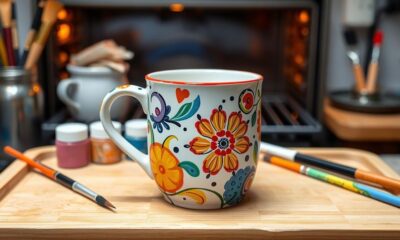
 Retreat2 weeks ago
Retreat2 weeks agoThe Ultimate Guide to Baking Acrylic Paint on Ceramic Mugs











